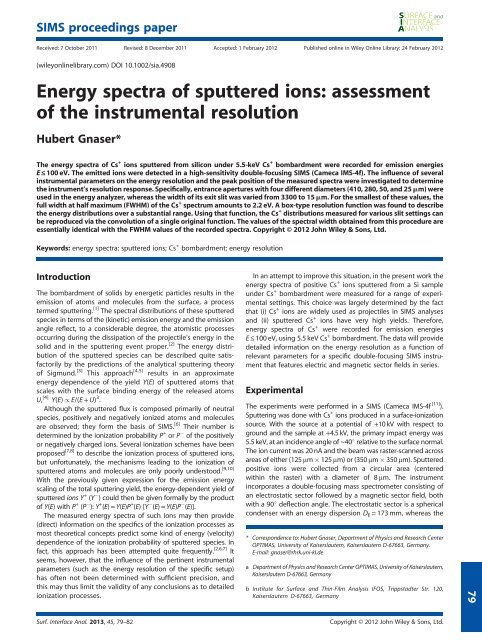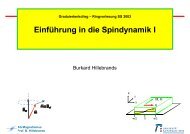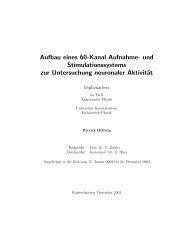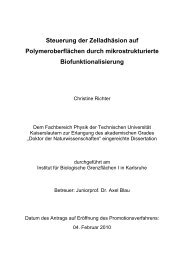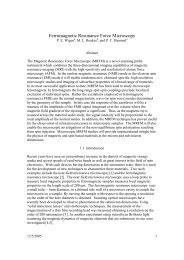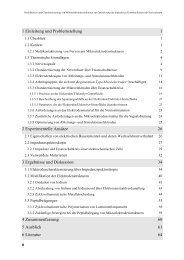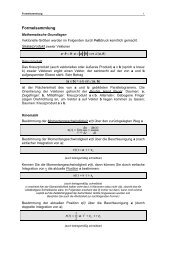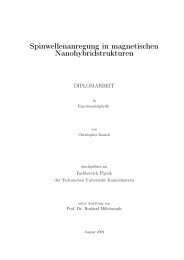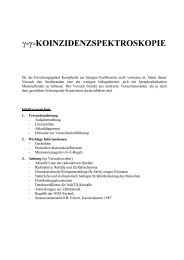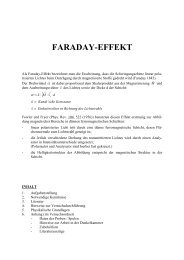Energy spectra of sputtered ions: assessment of the instrumental ...
Energy spectra of sputtered ions: assessment of the instrumental ...
Energy spectra of sputtered ions: assessment of the instrumental ...
You also want an ePaper? Increase the reach of your titles
YUMPU automatically turns print PDFs into web optimized ePapers that Google loves.
SIMS proceedings paper<br />
Received: 7 October 2011 Revised: 8 December 2011 Accepted: 1 February 2012 Published online in Wiley Online Library: 24 February 2012<br />
(wileyonlinelibrary.com) DOI 10.1002/sia.4908<br />
<strong>Energy</strong> <strong>spectra</strong> <strong>of</strong> <strong>sputtered</strong> <strong>ions</strong>: <strong>assessment</strong><br />
<strong>of</strong> <strong>the</strong> <strong>instrumental</strong> resolution<br />
Hubert Gnaser*<br />
The energy <strong>spectra</strong> <strong>of</strong> Cs + <strong>ions</strong> <strong>sputtered</strong> from silicon under 5.5-keV Cs + bombardment were recorded for emission energies<br />
E ≤ 100 eV. The emitted <strong>ions</strong> were detected in a high-sensitivity double-focusing SIMS (Cameca IMS-4f). The influence <strong>of</strong> several<br />
<strong>instrumental</strong> parameters on <strong>the</strong> energy resolution and <strong>the</strong> peak position <strong>of</strong> <strong>the</strong> measured <strong>spectra</strong> were investigated to determine<br />
<strong>the</strong> instrument’s resolution response. Specifically, entrance apertures with four different diameters (410, 280, 50, and 25 mm) were<br />
used in <strong>the</strong> energy analyzer, whereas <strong>the</strong> width <strong>of</strong> its exit slit was varied from 3300 to 15 mm. For <strong>the</strong> smallest <strong>of</strong> <strong>the</strong>se values, <strong>the</strong><br />
full width at half maximum (FWHM) <strong>of</strong> <strong>the</strong> Cs + spectrum amounts to 2.2 eV. A box-type resolution function was found to describe<br />
<strong>the</strong> energy distribut<strong>ions</strong> over a substantial range. Using that function, <strong>the</strong> Cs + distribut<strong>ions</strong> measured for various slit settings can<br />
be reproduced via <strong>the</strong> convolution <strong>of</strong> a single original function. The values <strong>of</strong> <strong>the</strong> <strong>spectra</strong>l width obtained from this procedure are<br />
essentially identical with <strong>the</strong> FWHM values <strong>of</strong> <strong>the</strong> recorded <strong>spectra</strong>. Copyright © 2012 John Wiley & Sons, Ltd.<br />
Keywords: energy <strong>spectra</strong>; <strong>sputtered</strong> <strong>ions</strong>; Cs + bombardment; energy resolution<br />
Introduction<br />
The bombardment <strong>of</strong> solids by energetic particles results in <strong>the</strong><br />
emission <strong>of</strong> atoms and molecules from <strong>the</strong> surface, a process<br />
termed sputtering. [1] The <strong>spectra</strong>l distribut<strong>ions</strong> <strong>of</strong> <strong>the</strong>se <strong>sputtered</strong><br />
species in terms <strong>of</strong> <strong>the</strong> (kinetic) emission energy and <strong>the</strong> emission<br />
angle reflect, to a considerable degree, <strong>the</strong> atomistic processes<br />
occurring during <strong>the</strong> dissipation <strong>of</strong> <strong>the</strong> projectile’s energy in <strong>the</strong><br />
solid and in <strong>the</strong> sputtering event proper. [2] The energy distribution<br />
<strong>of</strong> <strong>the</strong> <strong>sputtered</strong> species can be described quite satisfactorily<br />
by <strong>the</strong> predict<strong>ions</strong> <strong>of</strong> <strong>the</strong> analytical sputtering <strong>the</strong>ory<br />
<strong>of</strong> Sigmund. [3] This approach [4,5] results in an approximate<br />
energy dependence <strong>of</strong> <strong>the</strong> yield Y(E) <strong>of</strong> <strong>sputtered</strong> atoms that<br />
scales with <strong>the</strong> surface binding energy <strong>of</strong> <strong>the</strong> released atoms<br />
U, [4] Y(E) / E/(E + U) 3 .<br />
Although <strong>the</strong> <strong>sputtered</strong> flux is composed primarily <strong>of</strong> neutral<br />
species, positively and negatively ionized atoms and molecules<br />
are observed; <strong>the</strong>y form <strong>the</strong> basis <strong>of</strong> SIMS. [6] Their number is<br />
determined by <strong>the</strong> ionization probability P + or P <strong>of</strong> <strong>the</strong> positively<br />
or negatively charged <strong>ions</strong>. Several ionization schemes have been<br />
proposed [7,8] to describe <strong>the</strong> ionization process <strong>of</strong> <strong>sputtered</strong> <strong>ions</strong>,<br />
but unfortunately, <strong>the</strong> mechanisms leading to <strong>the</strong> ionization <strong>of</strong><br />
<strong>sputtered</strong> atoms and molecules are only poorly understood. [9,10]<br />
With <strong>the</strong> previously given expression for <strong>the</strong> emission energy<br />
scaling <strong>of</strong> <strong>the</strong> total sputtering yield, <strong>the</strong> energy-dependent yield <strong>of</strong><br />
<strong>sputtered</strong> <strong>ions</strong> Y + (Y ) could <strong>the</strong>n be given formally by <strong>the</strong> product<br />
<strong>of</strong> Y(E) withP + (P ): Y + (E)=Y(E)P + (E) [Y (E)=Y(E)P (E)].<br />
The measured energy <strong>spectra</strong> <strong>of</strong> such <strong>ions</strong> may <strong>the</strong>n provide<br />
(direct) information on <strong>the</strong> specifics <strong>of</strong> <strong>the</strong> ionization processes as<br />
most <strong>the</strong>oretical concepts predict some kind <strong>of</strong> energy (velocity)<br />
dependence <strong>of</strong> <strong>the</strong> ionization probability <strong>of</strong> <strong>sputtered</strong> species. In<br />
fact, this approach has been attempted quite frequently. [2,6,7] It<br />
seems, however, that <strong>the</strong> influence <strong>of</strong> <strong>the</strong> pertinent <strong>instrumental</strong><br />
parameters (such as <strong>the</strong> energy resolution <strong>of</strong> <strong>the</strong> specific setup)<br />
has <strong>of</strong>ten not been determined with sufficient precision, and<br />
this may thus limit <strong>the</strong> validity <strong>of</strong> any conclus<strong>ions</strong> as to detailed<br />
ionization processes.<br />
In an attempt to improve this situation, in <strong>the</strong> present work <strong>the</strong><br />
energy <strong>spectra</strong> <strong>of</strong> positive Cs + <strong>ions</strong> <strong>sputtered</strong> from a Si sample<br />
under Cs + bombardment were measured for a range <strong>of</strong> experimental<br />
settings. This choice was largely determined by <strong>the</strong> fact<br />
that (i) Cs + <strong>ions</strong> are widely used as projectiles in SIMS analyses<br />
and (ii) <strong>sputtered</strong> Cs + <strong>ions</strong> have very high yields. Therefore,<br />
energy <strong>spectra</strong> <strong>of</strong> Cs + were recorded for emission energies<br />
E ≤ 100 eV, using 5.5 keV Cs + bombardment. The data will provide<br />
detailed information on <strong>the</strong> energy resolution as a function <strong>of</strong><br />
relevant parameters for a specific double-focusing SIMS instrument<br />
that features electric and magnetic sector fields in series.<br />
Experimental<br />
The experiments were performed in a SIMS (Cameca IMS-4f [11] ).<br />
Sputtering was done with Cs + <strong>ions</strong> produced in a surface-ionization<br />
source. With <strong>the</strong> source at a potential <strong>of</strong> +10 kV with respect to<br />
ground and <strong>the</strong> sample at +4.5 kV, <strong>the</strong> primary impact energy was<br />
5.5 keV, at an incidence angle <strong>of</strong> ~40 relative to <strong>the</strong> surface normal.<br />
The ion current was 20 nA and <strong>the</strong> beam was raster-scanned across<br />
areas <strong>of</strong> ei<strong>the</strong>r (125 mm 125 mm) or (350 mm 350 mm). Sputtered<br />
positive <strong>ions</strong> were collected from a circular area (centered<br />
within <strong>the</strong> raster) with a diameter <strong>of</strong> 8 mm. The instrument<br />
incorporates a double-focusing mass spectrometer consisting <strong>of</strong><br />
an electrostatic sector followed by a magnetic sector field, both<br />
with a 90 deflection angle. The electrostatic sector is a spherical<br />
condenser with an energy dispersion D E = 173 mm, whereas <strong>the</strong><br />
* Correspondence to: Hubert Gnaser, Department <strong>of</strong> Physics and Research Center<br />
OPTIMAS, University <strong>of</strong> Kaiserslautern, Kaiserslautern D-67663, Germany.<br />
E-mail: gnaser@rhrk.uni-kl.de<br />
a Department <strong>of</strong> Physics and Research Center OPTIMAS, University <strong>of</strong> Kaiserslautern,<br />
Kaiserslautern D-67663, Germany<br />
b Institute for Surface and Thin-Film Analysis IFOS, Trippstadter Str. 120,<br />
Kaiserslautern D-67663, Germany<br />
79<br />
Surf. Interface Anal. 2013, 45, 79–82<br />
Copyright © 2012 John Wiley & Sons, Ltd.
H. Gnaser<br />
80<br />
magnetic sector features a homogeneous magnetic field with<br />
inclined field boundaries. The mass resolution was M/ΔM ~ 300.<br />
The detection <strong>of</strong> secondary <strong>ions</strong> was done by a discrete-dynode<br />
electron multiplier, and count rates were limited to
<strong>Energy</strong> <strong>spectra</strong> <strong>of</strong> <strong>sputtered</strong> <strong>ions</strong><br />
A ¼ R e jC e ja 2 (2)<br />
Calculated energy resolution ΔE (eV) FWHM Cs + energy spectrum (eV)<br />
10 2 CA1<br />
CA2<br />
CA3<br />
CA4<br />
10<br />
1<br />
10 10 2 10 3<br />
Exit slit width (µm)<br />
CA1<br />
CA2<br />
CA3<br />
CA4<br />
10<br />
1<br />
10 10 2 10 3<br />
10 2 (a)<br />
Exit slit width (µm)<br />
(b)<br />
The radius <strong>of</strong> <strong>the</strong> electrostatic sector is R e = 85 mm, <strong>the</strong><br />
constant C e = 3.5, and a is <strong>the</strong> angle to which <strong>the</strong> beam is<br />
constrained in <strong>the</strong> radial direction (a ~ 0.012). [21] With <strong>the</strong>se<br />
numbers, a value <strong>of</strong> A ~40mm is obtained. Eqn (1) may <strong>the</strong>n be<br />
used to estimate <strong>the</strong> <strong>the</strong>oretically predicted values <strong>of</strong> ΔE for <strong>the</strong><br />
different S 1 and S 2 ; Fig. 3(b) shows such an evaluation which<br />
produces a qualitative agreement with <strong>the</strong> experimental data.<br />
The discrepancies that are found might be due to <strong>the</strong> presence<br />
<strong>of</strong> <strong>the</strong> o<strong>the</strong>r optical elements (<strong>the</strong> magnetic sector and<br />
severa lenses), which follow <strong>the</strong> energy analyzer and possible<br />
uncertainties associated with <strong>the</strong> specific values <strong>of</strong> C e and a.<br />
It was noted in <strong>the</strong> context <strong>of</strong> Fig. 1 that for wide exit slits, <strong>the</strong><br />
energy <strong>spectra</strong> exhibit a box-type shape, at least in <strong>the</strong> lowenergy<br />
and <strong>the</strong> central parts. This feature is illustrated in Fig. 4,<br />
which depicts <strong>the</strong> distribut<strong>ions</strong> obtained for all four CAs and<br />
S 2 = 1400 mm. In a recent publication, [18] it was proposed that a<br />
box-shaped resolution function R(E) might be an appropriate<br />
description for <strong>the</strong> bandwidth in electric and magnetic sector-field<br />
instruments such as <strong>the</strong> one used in <strong>the</strong> present work. Specifically,<br />
<strong>the</strong> following normalized resolution function was applied<br />
RE ð Þ ¼ 1 <br />
<br />
4ΔE 1 þ erf E þ 0:5ΔE<br />
E<br />
pffiffiffi<br />
1 erf<br />
2 s<br />
<br />
0:5ΔE<br />
pffiffiffi<br />
2 s<br />
Eqn (3) constitutes <strong>the</strong> convolution <strong>of</strong> a rectangular box with a<br />
Gaussian <strong>of</strong> standard deviation s. [18] Such a box-type function<br />
R(E) is plotted in Fig. 4 (dashed line), using ΔE = 37.6 eV and<br />
s = 1.3 eV. Clearly, <strong>the</strong> function describes <strong>the</strong> experimental<br />
<strong>spectra</strong> quite well in <strong>the</strong> low-energy and <strong>the</strong> central parts.<br />
As suggested by Wittmaack, [18] <strong>the</strong> resolution function given in<br />
Eqn (3) could be used to compute energy <strong>spectra</strong> via a convolution<br />
using R(E). Their comparison with <strong>the</strong> corresponding experimental<br />
distribut<strong>ions</strong> would <strong>the</strong>n constitute a test as to <strong>the</strong> validity <strong>of</strong> <strong>the</strong><br />
resolution function. This approach was tested for several measured<br />
energy <strong>spectra</strong>. Figure 5 displays normalized Cs + distribut<strong>ions</strong><br />
(3)<br />
Figure 3. (a) The measured FWHM <strong>of</strong> <strong>the</strong> Cs + <strong>spectra</strong> as a function <strong>of</strong> <strong>the</strong><br />
exit slit width for <strong>the</strong> four CAs. (b) The energy resolution ΔE calculated<br />
according to Eqn (1), with an aberration <strong>of</strong> A =40mm.<br />
<strong>of</strong> <strong>the</strong> CAs. In addition, optical aberrat<strong>ions</strong> may possibly contribute<br />
to <strong>the</strong> values <strong>of</strong> <strong>the</strong> FWHM for small slit sizes.<br />
Theoretically, <strong>the</strong> relative energy resolution E/ΔE <strong>of</strong> an<br />
electrostatic sector analyzer such as <strong>the</strong> one in <strong>the</strong> present SIMS<br />
instrument depends on <strong>the</strong> energy dispersion D E , <strong>the</strong> widths <strong>of</strong><br />
<strong>the</strong> entrance and exits slits, S 1 and S 2 ,<strong>the</strong>analyzer’s magnification<br />
M, and some possible contribut<strong>ions</strong> due to optical aberration<br />
effects A [6] :<br />
E<br />
ΔE ¼ D E<br />
MS 1 þ S 2 þ A<br />
(1)<br />
Cs + intensity (normalized)<br />
10 -1 1<br />
10 -2<br />
10 -3<br />
S 2<br />
= 1400 μm<br />
CA1<br />
CA2<br />
CA3<br />
CA4<br />
Box-type<br />
In <strong>the</strong> present case, S 1 is determined by <strong>the</strong> diameter <strong>of</strong> <strong>the</strong><br />
CAs and M is unity because <strong>of</strong> <strong>the</strong> symmetry <strong>of</strong> <strong>the</strong> entrance<br />
and exit posit<strong>ions</strong> <strong>of</strong> <strong>the</strong> sector field. For an electrostatic<br />
sector, <strong>the</strong> contribution due to aberration in <strong>the</strong> radial plane is<br />
given by [19,20]<br />
-20 0 20 40 60<br />
Emission energy (eV)<br />
Figure 4. Normalized Cs + energy <strong>spectra</strong> for <strong>the</strong> four different CAs and<br />
<strong>the</strong> exit slit S 2 = 1400 mm (solid symbols). The dashed line is <strong>the</strong> resolution<br />
function given in Eqn (3).<br />
81<br />
Surf. Interface Anal. 2013, 45, 79–82 Copyright © 2012 John Wiley & Sons, Ltd. wileyonlinelibrary.com/journal/sia
H. Gnaser<br />
Cs + intensity (normalized)<br />
10 -1 1<br />
10 -2<br />
Exp S 2 (μm) Conv<br />
1400<br />
450<br />
190<br />
110<br />
CA4<br />
values <strong>of</strong> <strong>the</strong> entrance aperture and <strong>the</strong> exit slit <strong>the</strong> FWHM <strong>of</strong> <strong>the</strong><br />
Cs + energy <strong>spectra</strong> amounts to ~2.2 eV. Generally, <strong>the</strong> values <strong>of</strong><br />
<strong>the</strong> FWHM are in qualitative agreement with <strong>the</strong> energy resolution<br />
ΔE calculated for this energy analyzer. The data show that<br />
<strong>the</strong> different energy <strong>spectra</strong> can all be reproduced from a single<br />
original spectrum by a convolution procedure that is based on a<br />
box-type shape <strong>instrumental</strong> resolution function. In future work,<br />
a reversal <strong>of</strong> that approach (i.e. a deconvolution <strong>of</strong> measured<br />
<strong>spectra</strong>) could be attempted, with <strong>the</strong> objective <strong>of</strong> determining<br />
<strong>the</strong> “true” <strong>spectra</strong> <strong>of</strong> <strong>sputtered</strong> <strong>ions</strong>.<br />
Acknowledgement<br />
The author is grateful to Klaus Wittmaack for useful discuss<strong>ions</strong><br />
related to <strong>the</strong> subject <strong>of</strong> this work.<br />
10 -3<br />
obtained for CA4 and S 2 -values <strong>of</strong> 1400, 450, 190, and 110 mm(solid<br />
symbols with lines). The narrowest energy spectrum recorded in<br />
this study, namely, for S 2 =15mm and CA4 (cf. Fig. 2), was convolved<br />
with <strong>the</strong> resolution function, Eqn (3), using optimized values <strong>of</strong> ΔE<br />
and s (37.6/0.8, 10.6/0.6, 5.2/0.6, and 3.0 eV/0.5 eV, respectively).<br />
The resulting <strong>spectra</strong> are shown in Fig. 5 as open symbols. These<br />
ΔE-values are essentially identical with <strong>the</strong> FWHM <strong>of</strong> <strong>the</strong> respective<br />
<strong>spectra</strong> (cf. Fig. 3). The graph demonstrates that <strong>the</strong> experimental<br />
data can be reproduced ra<strong>the</strong>r accurately by <strong>the</strong> convolution procedure.<br />
This agreement corroborates <strong>the</strong> conjecture that a single type<br />
<strong>of</strong> resolution function is sufficient to describe <strong>the</strong> energy <strong>spectra</strong><br />
obtained in this instrument, independent <strong>of</strong> <strong>the</strong> specific settings<br />
<strong>of</strong> <strong>the</strong> entrance and exit slit widths.<br />
Conclus<strong>ions</strong><br />
-20 0 20 40 60<br />
Emission energy (eV)<br />
Figure 5. Normalized Cs + energy <strong>spectra</strong> for CA4 and <strong>the</strong> four different<br />
exit slit widths S 2 <strong>of</strong> 1400, 450, 190, and 110 mm (solid symbols and lines).<br />
The open symbols are <strong>the</strong> result <strong>of</strong> a convolution using <strong>the</strong> resolution<br />
function <strong>of</strong> Eqn (3).<br />
The energy <strong>spectra</strong> <strong>of</strong> Cs + <strong>ions</strong> <strong>sputtered</strong> from silicon under Cs +<br />
bombardment were recorded for different experimental settings<br />
to determine <strong>the</strong> instrument’s energy resolution. For <strong>the</strong> smallest<br />
References<br />
[1] P. Sigmund (ed), Fundamental Processes in Sputtering <strong>of</strong> Atoms and<br />
Molecules, K. Dan. Vidensk. Selsk. Mat. Fys. Medd. 43, 1993.<br />
[2] H. Gnaser, in Sputtering by Particle Bombardment (Eds: R. Behrisch,<br />
W. Eckstein), Springer, Berlin, 2007, p. 231.<br />
[3] P. Sigmund, Phys. Rev. 1969, 184, 383.<br />
[4] P. Sigmund, in Sputtering by Particle Bombardment I (Ed: R. Behrisch),<br />
Springer, Berlin, 1981, p.9.<br />
[5] M. W. Thompson, Phys. Rep. 1981, 69, 335.<br />
[6] A. Benninghoven, F. G. Rüdenauer, H. W. Werner, Secondary Ion<br />
Mass Spectrometry, Wiley, New York, 1987.<br />
[7] M. L. Yu, in Sputtering by Particle Bombardment III (Eds: R. Behrisch,<br />
K. Wittmaack), Springer, Berlin, 1991, p. 91.<br />
[8] P. Williams, Surf. Sci. 1979, 90, 588.<br />
[9] K. Wittmaack, K. Dan. Vidensk. Selsk. Mat. Fys. Medd., 2006, 52, 465.<br />
[10] A. Wucher, Appl. Surf. Sci. 2008, 255, 1194.<br />
[11] H. N. Migeon, C. Le Pipec, J. J. Le Goux, in Secondary Ion Mass<br />
Spectrometry SIMS V (Eds: A. Benninghoven, R. J. Colton, D. S. Simons,<br />
H. W. Werner), Springer, Berlin, 1986, p. 155.<br />
[12] H. Gnaser, H. Oechsner, Surf. Interface Anal. 1994, 21, 257.<br />
[13] H. Gnaser, Phys. Rev. B 1996, 54, 17141.<br />
[14] H. Gnaser, Nucl. Instrum. Methods B 1999, 149, 38.<br />
[15] H. Gnaser, Phys. Rev. B 2001, 63, 045415.<br />
[16] H. Gnaser, Nucl. Instrum. Methods B 2011, 269, 990.<br />
[17] K. Wittmaack, Int. J. Mass Spectrom. 2008, 269, 24.<br />
[18] K. Wittmaack, Int.. J. Mass Spectrom. 2011, 300, 65.<br />
[19] H. Wollnik, in Focusing <strong>of</strong> Charged Particles (Ed: A. Septier), Academic,<br />
New York, 1967, p. 163.<br />
[20] G. Slodzian, in Applied Charge Particle Optics (Ed: A. Septier), Academic,<br />
New York, 1980, p.1.<br />
[21] M. Lepareur, Rev. Techn. Thomson-CSF 1980, 12, 225.<br />
82<br />
wileyonlinelibrary.com/journal/sia Copyright © 2012 John Wiley & Sons, Ltd. Surf. Interface Anal. 2013, 45, 79–82


